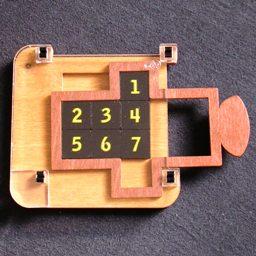


Palette 7 is a puzzle with 7 square numbered pieces. The pieces lie inside a 3×3 base, and are also held inside a cross-shaped frame. The top and bottom arms of this cross can hold only 1 piece, and the left and right arms a 2×2 square of pieces. By moving the frame horizontally or vertically, the pieces are moved about the 3×3 square. In the solved position the frame is at the bottom right, with piece 1 on its own in the top row, and below that rows containing 2,3,4 and 5,6, and 7.
These puzzles were invented by Douglas A. Engel, who also invented various other puzzles such as:
If your browser supports JavaScript, then you can play Palette 7 by clicking the link below:
There are 7 pieces and, as with any puzzle that essentially only uses plungers to move the pieces, only even permutations of the pieces are possible. This gives 7! / 2 = 2520 positions of the pieces for any frame position. The frame can be positioned in 3×2 = 6 ways, so there are really only 6·7! / 2 = 15,120 positions.
I used a computer to calculate God's algorithm, and the result is shown in the following table. Sliding the frame one tile in any direction is considered a single move. Every position can be solved in at most 37 moves (25.469 on average).
|
|
|
 The unique antipodal position at depth 37 is shown on the left.
The unique antipodal position at depth 37 is shown on the left.
There are two move sequences that we will use in the solution. Start with frame at the bottom-centre position, so that single piece in the top row is centred. The two move sequences we can do are then:
| LURD | Anti-clockwise 5-cycle of left hand side |  |
| RULD | Clockwise 5-cycle of right hand side |  |
Of course these sequences can also be done in reverse to cycle pieces in
the opposite direction.
These move sequences can be combined to make one much more useful one:
| (RULD LURD LURD)2 | 3-cycle of right hand column |  |
This sequence consists of the previously mentioned right and left cycles, in the order right, left, left, right, left, left.